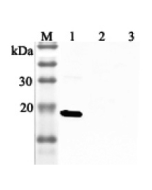Cookie Policy: This site uses cookies to improve your experience. You can find out more about our use of cookies in our Privacy Policy. By continuing to browse this site you agree to our use of cookies.
AdipoGen Life Sciences
anti-IL-33 (human), mAb (IL33305B)

A. Immunoperoxidase staining (cytoplasmic) of formalin-fixed, paraffin-embedded human heart (100x, brown colour).
B. Isotype control with IgG2a (negative control).
1. Recombinant human IL-33 (His tagged).
2. Recombinant human IL-33 (FLAG®-tagged).
3. Recombinant mouse IL-33 (FLAG®-tagged).
4. Other protein (His tagged, negative control).
| Product Details | |
|---|---|
| Synonyms | Interleukin-33; IL-1F11; NF-HEV |
| Product Type | Monoclonal Antibody |
| Properties | |
| Clone | IL33305B |
| Isotype | Mouse IgG2aκ |
| Immunogen/Antigen | Recombinant human IL-33. |
| Application |
ELISA: (direct or indirect: 1:2'000-1:5'000) |
| Crossreactivity | Human |
| Specificity |
Recognizes human IL-33. Does not cross-react with mouse IL-33. |
| Purity Detail | Protein G-affinity purified. |
| Concentration | 1mg/ml |
| Formulation | Liquid. 0.2μm-filtered solution in PBS, pH 7.4. Contains no preservatives. |
| Isotype Negative Control | |
| Shipping and Handling | |
| Shipping | BLUE ICE |
| Short Term Storage | +4°C |
| Long Term Storage | -20°C |
| Handling Advice |
After opening, prepare aliquots and store at -20°C. Avoid freeze/thaw cycles. |
| Use/Stability | Stable for at least 1 year after receipt when stored at -20°C. |
| Documents | |
| MSDS |
 Download PDF Download PDF |
| Product Specification Sheet | |
| Datasheet |
 Download PDF Download PDF |
Interleukin-33 (IL-33; HF-NEV; IL-1F11), a member of the IL-1 family of cytokines, is expressed by many cell types following pro-inflammatory stimulation and is thought to be released on cell lysis. The 30kDa human IL33 is converted by CASP1 to a 18kDa protein. IL33 binds to and signals through ST2 (IL1R1) and its stimulation recruits MYD88, IRAK, IRAK4, and TRAF6, followed by phosphorylation of ERK1 (MAPK3)/ERK2 (MAPK1), p38(MAPK14), and JNK. The ability of IL-33 to target numerous immune cell types, like Th2-like cells, mast cells, and B1 cells, and to induce cytokine and chemokine production underlines its potential in influencing the outcome of a wide range of diseases, such as arthritis, asthma, atopic allergy & anaphylaxis, cardiovascular disease/atherosclerosis, nervous system diseases, and sepsis.
- Inhibition of interleukin-33 signaling attenuates the severity of experimental arthritis: G. Palmer, et al.; Arthritis & Rheum. 60, 738 (2009)
- Transcriptomic and genetic studies identify IL-33 as a candidate gene for Alzheimer's disease: J. Chapuis, et al.; Mol. Psychiatry 14, 1004 (2009) (Supplement Information)
- Interleukin-33 is biologically active independently of caspase-1 cleavage: D. Talabot-Ayer, et al.; JBC 284, 19420 (2009)
- Cigarette smoke alters IL-33 expression and release in airway epithelial cells: E. Pace, et al.; Biochim. Biophys. Acta 1842, 1630 (2014)








